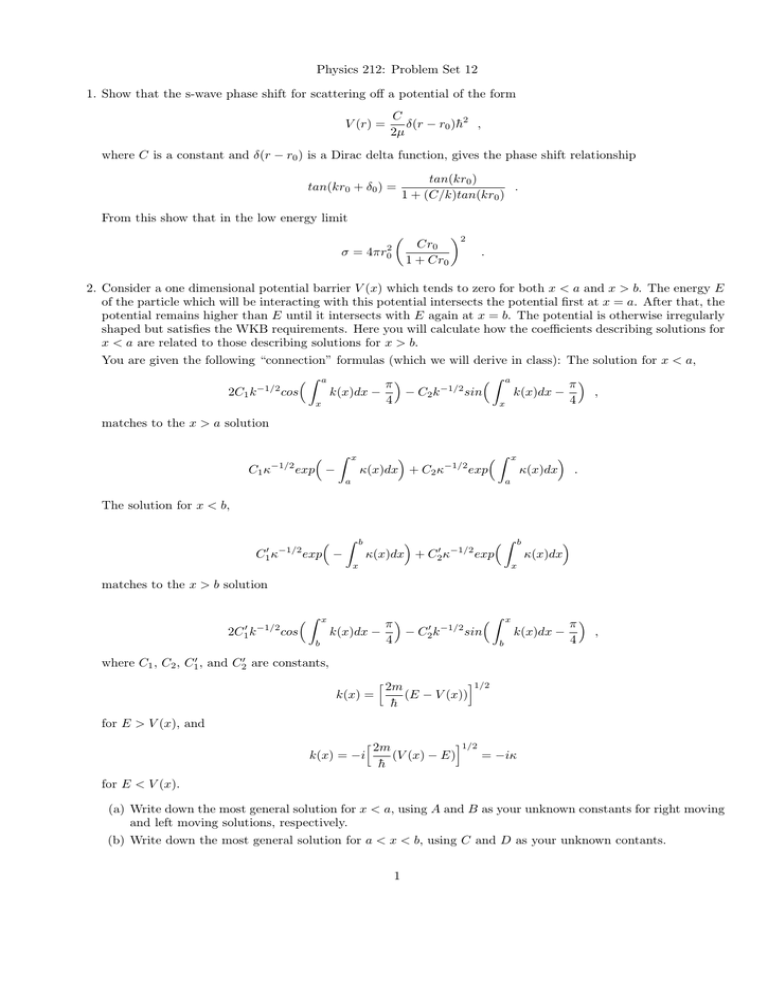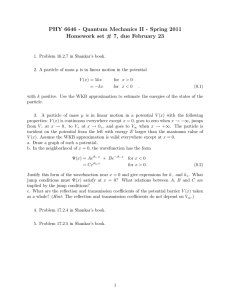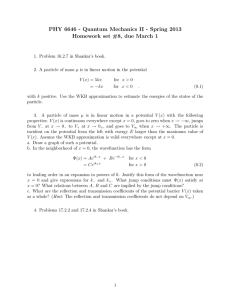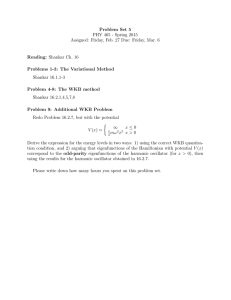Quantum Mechanics Problem Set: Scattering & WKB
advertisement

Physics 212: Problem Set 12 1. Show that the s-wave phase shift for scattering off a potential of the form V (r) = C δ(r − r0 )h̄2 , 2µ where C is a constant and δ(r − r0 ) is a Dirac delta function, gives the phase shift relationship tan(kr0 + δ0 ) = tan(kr0 ) . 1 + (C/k)tan(kr0 ) From this show that in the low energy limit σ= 4πr02 Cr0 1 + Cr0 2 . 2. Consider a one dimensional potential barrier V (x) which tends to zero for both x < a and x > b. The energy E of the particle which will be interacting with this potential intersects the potential first at x = a. After that, the potential remains higher than E until it intersects with E again at x = b. The potential is otherwise irregularly shaped but satisfies the WKB requirements. Here you will calculate how the coefficients describing solutions for x < a are related to those describing solutions for x > b. You are given the following “connection” formulas (which we will derive in class): The solution for x < a, Z a Z a π π 2C1 k −1/2 cos k(x)dx − − C2 k −1/2 sin k(x)dx − , 4 4 x x matches to the x > a solution −1/2 C1 κ x Z x Z −1/2 κ(x)dx + C2 κ exp exp − a κ(x)dx . a The solution for x < b, C10 κ−1/2 exp Z b − Z 0 −1/2 κ(x)dx + C2 κ exp x b κ(x)dx x matches to the x > b solution Z 2C10 k −1/2 cos x k(x)dx − b π − C20 k −1/2 sin 4 Z x k(x)dx − b π , 4 where C1 , C2 , C10 , and C20 are constants, k(x) = h 2m h̄ i1/2 (E − V (x)) for E > V (x), and h 2m i1/2 k(x) = −i (V (x) − E) = −iκ h̄ for E < V (x). (a) Write down the most general solution for x < a, using A and B as your unknown constants for right moving and left moving solutions, respectively. (b) Write down the most general solution for a < x < b, using C and D as your unknown contants. 1 (c) Write down the most general solution for x > b using F and G as your unknown constants for right moving and left moving solutions, respectively. (d) Using the connection formulas given above, show that A B = 1 4α i + α − 4α + iα i 4α − iα 1 4α +α F G , where α = exp Z b κ(x)dx . a (e) If the particle is incident from the left, show that the transmission coefficient for the particle to traverse the barrier is 1 −2 T = +α . 4α (f) A car of mass 500kg and energy 4J attempts to tunnel through a mountain described by the potential V (x) = (5 − x2 ) J. Assuming the WKB conditions apply, what is the probability the car makes it to the far side of the mountain? 3. Shankar Problem 8.6.1 4. Shankar Problem 8.6.2 5. Shankar Problem 8.6.3 2







